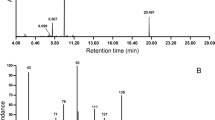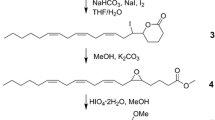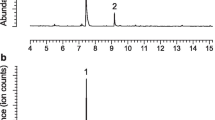Abstract
The scarab genus Osmoderma (Coleoptera: Scarabaeidae) includes several large species called hermit beetles that develop within dead and decaying hardwood trees. Males of at least three Palearctic species produce the aggregation-sex pheromone (R)-(+)-γ-decalactone, including the endangered O. eremita (Scopoli). However, hermit beetles have received less attention in the western hemisphere, resulting in a large gap in our knowledge of the chemical ecology of Nearctic species. Here, we identify (R)-( +)-γ-decalactone as the primary component of the aggregation-sex pheromone of the North American species Osmoderma eremicola (Knoch). Field trials at sites in Wisconsin and Illinois revealed that both sexes were attracted to lures containing (R)-(+)-γ-decalactone or the racemate, but only males of O. eremicola produced the pheromone in laboratory bioassays, alongside an occasional trace of the chain-length analog γ-dodecalactone. Females of the congener O. scabra (Palisot de Beauvois) were also significantly attracted by γ-decalactone, suggesting further conservation of the pheromone, as were females of the click beetle Elater abruptus Say (Coleoptera: Elateridae), suggesting that this compound may have widespread kairomonal activity. Further research is needed to explore the behavioral roles of both lactones in mediating behavioral and ecological interactions among these beetle species.



Similar content being viewed by others
Data Availability
No datasets were generated or analysed during the current study.
References
Audisio P, Brustel H, Carpaneto GM, Coletti G, Mancini E, Piattella E, Trizzino M, Dutto M, Antonini G, De Biase A (2007) Updating the taxonomy and distribution of the European Osmoderma, and strategies for their conservation (Coleoptera, Scarabaeidae, Cetoniinae). Fragm Entomol 39:273–290
Audisio P, Brustel H, Carpaneto GM, Coletti G, Mancini E, Trizzino M, Antonini G, De Biase A (2008) Data on molecular taxonomy and genetic diversification of the European Hermit beetles, a species complex of endangered insects (Coleoptera: Scarabaeidae, Cetoniinae, Osmoderma). J Zool Syst Evol Res 47:88–95
Bezborodov VG (2015) The Genus Osmoderma (Coleoptera, Scarabaeidae, Trichiinae) in Siberia and the Russian Far East. Entomol Rev 95:1088–1098
Graham EE, Mitchell RF, Reagel PF, Barbour JD, Millar JG, Hanks LM (2010) Treating panel traps with a fluoropolymer enhances their efficiency in capturing cerambycid beetles. J Econ Entomol 103:641–647
Grommes AC, Millar JG, Hanks LM (2023) Dose–responses of seven species of cerambycid beetles to synthesized pheromones in field experiments. J Econ Entomol 116:2035–2042
Hoffmann CH (1939) The biology and taxonomy of the nearctic species of Osmoderma (Coleoptera, Scarabaeidae). Ann Entomol Soc Am 32:510–525
Howden HF (1968) A review of the Trichiinae of North and Central America (Coleoptera: Scarabaeidae). Mem Entomol Soc Can 100:5–77
Landvik M, Miraldo A, Niemelä P, Valainis U, Cibuļskis R, Roslin T (2017) Evidence for geographic substructuring of mtDNA variation in the East European Hermit beetle (Osmoderma barnabita). Nat Conserv 19:171–189
Larsson MC, Hedin J, Svensson GP, Tolasch T, Francke W (2003) Characteristic odor of Osmoderma eremita identified as a male-released pheromone. J Chem Ecol 29:575–873
Micó E (2018) Saproxylic insects in tree hollows. In: Ulyshen MD (ed) Saproxylic insects: diversity, ecology and conservation. Zoological monographs, vol 1. Springer, Cham, pp 693–727
Millar JG, Hanks LM (2017) Chemical ecology of cerambycids. In: Wang Q (ed) Cerambycidae of the world: biology and pest management. CRC Press/Taylor & Francis, Boca Raton, pp 161–208
Mitchell RF, Reagel PF, Wong JC, Meier LR, Silva WD, Mongold-Diers J, Millar JG, Hanks LM (2015) Cerambycid beetle species with similar pheromones are segregated by phenology and minor pheromone components. J Chem Ecol 41:431–440
Praz CJ, Packer L (2014) Phylogenetic position of the bee genera Ancyla and Tarsalia (Hymenoptera: Apidae): a remarkable base compositional bias and an early Paleogene geodispersal from North America to the Old World. Mol Phylogenet Evol 81:258–270
R Core Team (2022) R: a language and environment for statistical computing. R Foundation for Statistical Computing, Vienna
Ren Z, Zhong Y, Kurosu U, Aoki S, Ma E, von Dohlen CD, Wen J (2013) Historical biogeography of Eastern Asian-Eastern North American disjunct Melaphidina aphids (Hemiptera: Aphididae: Eriosomatinae) on Rhus hosts (Anacardiaceae). Mol Phylogenet Evol 69:1146–1158
Ranius T (2002) Osmoderma eremita as an indicator of species richness of beetles in tree hollows. Biodivers Conserv 11:931–941
Ranius T, Hedin J (2001) The dispersal rate of a beetle, Osmoderma eremita, living in tree hollows. Oecologia 126:363–370
Ranius T, Aguado LO, Antonsson K, Audisio P, Ballerio A, Carpaneto GM, Chobot K, Gjurašin B, Hanssen O, Huijbregts H, Lakatos F, Martin O, Neculiseanu Z, Nikitsky NB, Paill W, Pirnat A, Rizun V, Ruicanescu A, Stegner AJ, Süda I, Szwako P, Tamutis V, Telnov D, Tsinkevich V, Versteirt V, Vignon V, Vögeli M, Zach P (2005) Osmoderma eremita (Coleoptera, Scarabaeidae, Cetoniidae) in Europe. Anim Biodivers Conserv 28:1–44
Ratcliffe BC (1977) Descriptions of the larva and pupa of Osmoderma subplanata (Casey) and Cremastocheilus wheeleri LeConte (Coleoptera: Scarabaeidae). J Kan Entomol Soc 50:363–370
Svensson GP, Larsson MC (2008) Enantiomeric specificity in a pheromone–kairomone system of two threatened saproxylic beetles, Osmoderma eremita and Elater ferrugineus. J Chem Ecol 34:189–197
Svensson GP, Larsson MC, Hedin J (2004) Attraction of the larval predator Elater ferrugineus to the sex pheromone of its prey, Osmoderma eremita, and its implication for conservation biology. J Chem Ecol 30:353–363
Svensson GP, Oleksa A, Gawroński R, Lassance JM, Larsson MC (2009) Enantiomeric conservation of the male-produced sex pheromone facilitates monitoring of threatened European hermit beetles (Osmoderma spp.). Entomol Expt Appl 133:276–282
Svensson GP, Sahlin U, Brage B, Larsson MC (2011) Should I stay or should I go? Modelling dispersal strategies in saproxylic insects based on pheromone capture and radio telemetry: a case study on the threatened hermit beetle Osmoderma eremita. Biodivers Conserv 12:2883–2902
Waldrop, B, Christensen TA, Hildebrand JG (1987) GABA-mediated synaptic inhibition of projection neurons in the antennal lobes of the sphinx moth, Manduca sexta. J Comp Physiol A 161:23–32
Wittkowski KM, Song T (2012) muStat: Prentice rank sum test and McNemar test. R package version 1.7.0, R Foundation for Statistical Computing, Vienna
Zauli A, Carpaneto GM, Chiari S, Mancini E, Nyabuga FN, Redolfi De Zan L, Romiti F, Sabbani S, Audisio PA, Hedenström E, Bologna MA, Svensson GP (2016) Assessing the taxonomic status of Osmoderma cristinae (Coleoptera: Scarabaeidae), endemic to Sicily, by genetic, morphological and pheromonal analyses. J Zool Syst Evol Res 54:206–214
Acknowledgements
We thank Dr. Toivo Kallas (UW Oshkosh) for providing larval specimens of O. eremicola, Dr. Kevin Crawford (UW Oshkosh) for GC-MS technical support, Jackie Behrens (UW Oshkosh) for preparing specimens, Dr. Jocelyn Millar and Sean Halloran (UC Riverside) for assistance in determining absolute configuration, and two anonymous reviewers for their comments on the manuscript. Additional thanks to AGM Nature Preserve, Mosquito Hill Nature Preserve, Robert Allerton Park, and Forest Glen Preserve for access to parkland, and Ze Her and Lucy Cowan for access to additional field sites.
Funding
This work was supported by the collaborative grants program at the University of Wisconsin Oshkosh (to GLS and RFM), and a TRIO Grant from the US Dept. of Education PR/Award Number P217A220180 (to GLS).
Author information
Authors and Affiliations
Contributions
GLS and RFM conceptualized and designed this experiment. All authors assisted with data collection. Data analysis was completed by GLS and RFM. The first draft of the manuscript was written by GLS. All authors edited and approved the final manuscript.
Corresponding author
Ethics declarations
Competing Interests
The authors declare no competing interests.
Supplementary Information
Below is the link to the electronic supplementary material.
10886_2024_1475_MOESM1_ESM.pdf
Supplementary file1 Fig. S1 GC-FID traces illustrating isothermal (130 °C) injections of racemic γ-decalactone, (R)-(+)-γ-decalactone, headspace extract from a male of Osmoderma eremicola, and a combined injection of racemic γ-decalactone and the headspace extract (PDF 54 kb)
10886_2024_1475_MOESM2_ESM.pdf
Supplementary file2 Fig. S2 GC-FID traces illustrating isothermal (125 °C) injections of racemic γ-dodecalactone, headspace extract from a male of Osmoderma eremicola, and a combined injection of racemic γ-dodecalactone and the headspace extract (PDF 65 kb)
Rights and permissions
Springer Nature or its licensor (e.g. a society or other partner) holds exclusive rights to this article under a publishing agreement with the author(s) or other rightsholder(s); author self-archiving of the accepted manuscript version of this article is solely governed by the terms of such publishing agreement and applicable law.
About this article
Cite this article
Steffek, G.L., Grommes, A.S., Hanks, L.M. et al. (R)-(+)-γ-Decalactone is Conserved in North America as a Pheromone Component of Osmoderma eremicola (Coleoptera: Scarabaeidae) and a Kairomone of Elater abruptus (Coleoptera: Elateridae). J Chem Ecol 50, 122–128 (2024). https://doi.org/10.1007/s10886-024-01475-0
Received:
Revised:
Accepted:
Published:
Issue Date:
DOI: https://doi.org/10.1007/s10886-024-01475-0




